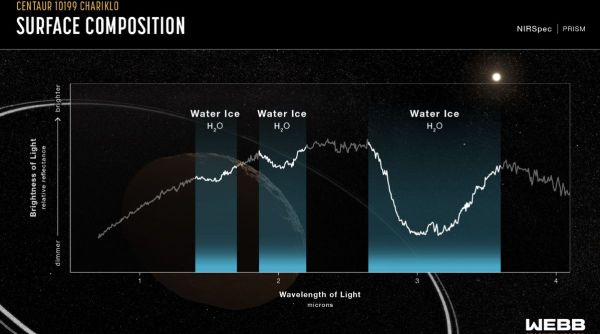James Webb Space Telescope helps scientists study icy rings of asteroid Chariklo
Discovered in 1997, 10199 Chariklo is the first asteroid to have a ring system. Scientists have now used the James Webb Space Telescope to study the distant asteroid and its icy rings.
 Artists's impression of how the asteroid Charilko's rings will look like from a vantage point close to its surface. (Image credit: NASA)
Artists's impression of how the asteroid Charilko's rings will look like from a vantage point close to its surface. (Image credit: NASA) In what NASA is calling an observational feat of high precision, scientists have used a new technique with the James Webb Space Telescope to capture the shadows of starlight cast by the rings of the distant asteroid Chariklo.
Discovered in 1997, 10199 Chariklo is the first asteroid found to have a ring system. In fact, it was only the fifth celestial object discovered to have a ring system—after Saturn, Jupiter, Uranus and Neptune. The small icy asteroid is located more than 3 billion kilometres away beyond the orbit of Saturn. Even though it is the largest object known in the centaur formation of small bodies, it measures only about 250 kilometres, making it around 51 times smaller than our planet.
In 2013, NASA scientists used ground-based telescopes and discovered that Chariklo hosts a system that has two thin rings. Until the discovery, such rings were only expected around large bodies like Jupiter and Neptune. The astronomers discovered the rings as Chariklo passed in front of it, blocking the starlight. This phenomenon is called occultation in astronomy.
Interestingly, the star blinked twice before disappearing behind Chariklo and double-blinked again after the star reemerged. This blinking of starlight was caused by the two rings of the asteroid.
NASA returned to Chariklo again on October 18 last year when they used Webb’s NIRCam (Near-Infrared Camera) instrument to closely monitor a distant star with a mouthful of a name—DR3 6873519665992128512. They then watched for tell-tale dips in the brightness of the star and were able to detect the rings of Chariklo.
“As we delve deeper into the data, we will explore whether we cleanly resolve the two rings. From the shapes of rings’ occultation light curves, we also will explore the rings’ thickness, the sizes and colours of the ring particles, and more. We hope to gain insight into why this small body even has rings at all, and perhaps detect new fainter rings,” said Pablo Santos-Sanz, from Instituto de Astrofísica de Andalucía in Granada, in a press statement.
Shortly after the occultation, Webb targeted Chariklo once again, but this time, to collect observations of the starlight reflected by the asteroid and its rings. The spectroscopic data of the system revealed three absorption bands of water ice around Chariklo.
 Spectroscopic data of Charilko obtained by Webb helped scientists confirm the presence of water ice in the system. (Image credit: NASA, ESA, CSA, Leah Hustak (STScI))
Spectroscopic data of Charilko obtained by Webb helped scientists confirm the presence of water ice in the system. (Image credit: NASA, ESA, CSA, Leah Hustak (STScI))
“Spectra from ground-based telescopes had hinted at this ice (Duffard et al. 2014), but the exquisite quality of the Webb spectrum revealed the clear signature of crystalline ice for the first time,” said Noemí Pinilla-Alons, who led the Webb spectroscopic analysis of Chariklo, in a press statement.
Most of the light that is reflected by the system comes from the asteroid itself. Current models suggest that the observed ring area is likely one-fifth the area of the body itself. But scientists will need to observe Chariklo with Webb over a period of several years as the viewing angle changes to isolate the contribution of the rings themselves.







